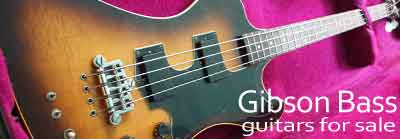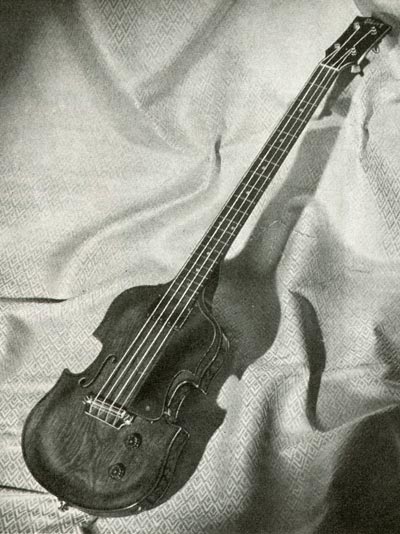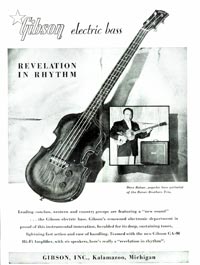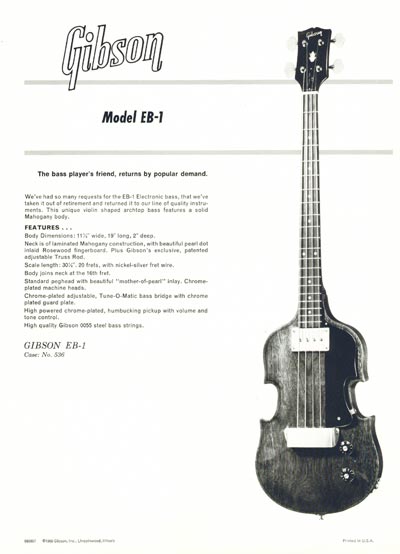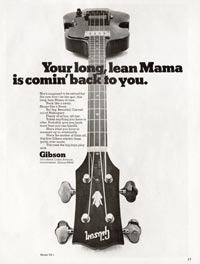Solid body guitars and basses really took off in the early 1950s. Fender launched the Precision in 1951, with Gibson launching the Electric Bass, or Gibson EB bass in mid 1953. It shipped until 1958, being renamed EB-1 once the EB-0 and EB-2 models were added to the line. Gibson artist, Les Paul, chose the body style:
"This was one of the first electric bass guitars Gibson made. I was responsible for the violin shape"
"It all came about (the electric guitar bass) from me playing my E string on the guitar as a bass using my thumb - this proved it could replace a stand up bass and Leo Fender & lots of others picked up the idea"
Unlike Fender bass guitars, the Gibson Electric Bass was short (30 1/2") scale, but this was far from the only difference. The body was small, and finely sculptured; carved from a single piece of mahogany, with a mahogany set neck, rosewood fingerboard and a lovely translucent finish. These two basses could not be more different.
The Gibson EB bass shipped for just five year between 1953 and 1958, with 526 basses produced. The model was reissued between 1970 and 1973 with just 473 basses shipped. See the detailed shipping figures below.
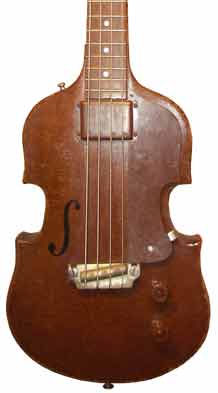
The original EB bass had a single single coil pickup - quite atypical for a Gibson bass. But when the model was reissued in 1970, it was fitted with the same EB humbucker as fitted to the EB0, EB2 and EB3; and still in the neck position. You see plenty of these basses with an added bridge pickup, but they never left the factory that way.
The EB single coil bass pickup was designed and built by Gibson engineers Walter Fuller and Seth Lover. According to Fuller, the coil had 250000 turns, and was so large, it had to be rotated to fit in the pickup route, explaining why the polepieces were along one edge, rather than centered (as quoted in Duchossoir's excellent Gibson Electrics: The Classic Years)
"By having them on the edge we got, you might say, the advantage of that much difference in the positioning of the coil. We [later] got more action from the polepieces in the center, but with the adjustable polepieces on the back edge of the coil like that, we got a little brighter tone than we did with them in the centre"
In an interview with Seymour Duncan, Seth lover adds:
Seth Lover: "I can remember when I was working on the first bass pickup, the non-humbucking bass pickup--Wilbur Marker came in there each time I would get one ready and he would try it out--”that’s better than the other, but not quite right,” so we would make some changes and go on - wind up another. We finally go to the point where you had to stop--you could have gone on forever and never been exactly perfect. But, now we had some very good years there. When I can begin to hear the differences I make certain tests - I can hear the differences between them, and then when they would corroborate what I could hear, then we knew we were getting somewhere."
Seymour Duncan: "How did you figure out the number of turns for the type of frequency - if you put too many turns on, when do you start loosing your high end?"
Seth Lover: "Well, I was just simply using # 42 plain enamel magnet wire. I put as many turns as I could satisfactorily fill the space available. And that’s where we stopped right there. "
The Gibson EB-1 Reissue
The EB-1 was reissued in 1970, with a price tag of $395 - $5 more than the EB3, and $70 more than the similarly equipped EB-0. Actually production started in 1969, with publicity material appearing that year, though shipping figures suggest none left Kalamazoo until 1970. It was described as follows in the 1970 Gibson catalog.
Versatility! that's the best way to describe this outstanding electric 'violin shaped' bass. Play the EB-1 the conventional way - in horizontal position. Or use the telescopic stand, and perform with the instrument in an upright position.
1970 was the single most popular year for the Electric Bass, with 404 instruments shipped that year.
Gibson EB shipping totals
| 1953 | 1954 | 1955 | 1956 | 1957 | 1958 | 1970 | 1971 | 1972 | 1973 | total | ||
| EB | 105 | 125 | 127 | 65 | 79 | 45 | 546 | |||||
| EB-1 | 404 | 65 | 2 | 2 | 473 |
Well known users of the EB/EB-1 Bass include Little Richard's bassplayer, Olsie Robinson (bass currently owned by Bob Daisley - see it in this Bob Daisley interview), John Paul Jones, Jack Bruce, Felix Pappalardi, Dave Kiswiney and many more.
Gibson EB-1 bass guitars for sale
1967 / 68 / 69 Gibson USA EB Bass Husk - Routed
Garland, Texas, 750**, UNITED STATES OF AMERICA
$795
Buyer pays $60 shipping and insurance.
Thanks for looking.
... more
? For Sale: Legendary 1969 Gibson EB-1 Bass ?? A Piece of Rock History! ?
Danbury, Connecticut, 068**, UNITED STATES OF AMERICA
$4500
? For Sale: Legendary 1969 Gibson EB-1 Bass ?? A Piece of Rock History! ?
Own a true piece of music history!
This 1969 Gibson EB-1 Bass is in excellent condition and comes with an incredible pedigree.
This iconic instrument was played by some of the most legendary bassists in rock history:
John Paul Jones of Led Zeppelin
Jack Bruce of Cream
Felix Pappalardi of Mountain
The bass is in excellent shape, with only the pickguard and bridge cover missing ?? a small ... more
Gibson EB-1 Violin Bass Electric Bass w / Original Case SN: 810964 Instrument
Lafayette, Indiana, 479**, UNITED STATES OF AMERICA
$4730
Gibson EB Bass Guitar, Natural Relic With Hard Case, Case Candy & Free Shipping
Belper, DE56***, UNITED KINGDOM
£2042
34" scale maple neck with rosewood fingerboard
Swamp ash body
Weight: 8 1 lbs
Pair of Alnico red bass humbuckers with coil taps
Babicz Full Contact bridge
This full-scale, 4-string bass follows a long line of great EB models, while bringing and entirely new shape, look, sound, and versatility to the board??all representing truly unbelievable value for a hand-made-in-America ... more
Gibson EB-13 Bass
Admannshagen-Bargeshagen, 18***, GERMANY
€1819
Der Bass ist ??Made in USA?? und typisch gibsonmäßig verarbeitet. Alles funktioniert einwandfrei und optisch weist der Bass nur die typischen Lackspuren auf. Der Nitrolack ist natürlich ... more
I'm interested in opinions on the various EB/EB1 variants. Are the 50s EBs much different to the 1969 reissues. And what is a good price for either?

